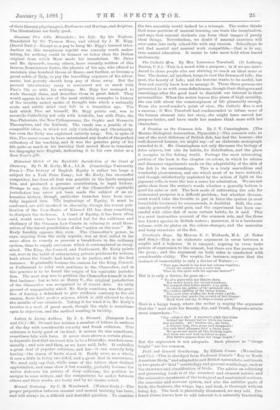Giovanni Pico della Mirando/a : his We. By his Nephew.
Translated by Sir Thomas More, and edited by J. M. Rigg. (David Nutt.)—Except as a peg to hang Mr. Rigg's learned intro- duction on, this sumptuous reprint was scarcely worth under- taking for nothing could be thinner or triter than the Italian original from which More made his translation. Mr. Pater and Mr. Symonds, among others, have recently written of this famous Renaissance figure, the phomix of his age, who offered to maintain nine hundred theses at Rome; and further, as became a great noble of Italy, to pay the travelling expenses of his adver- saries, lest poverty should keep any of them away. But the present introductory essay is concerned net so much with Pico's life as with his writings, Mr. Rigg has managed to wade through these, and describes them in great detail. They would appear to be one of the most striking examples in history of the terribly mixed modes of thought into which a naturally acute and subtle Mind may fall in a transition age. The task which Pico . set himself, Mr. Rigg points out, was to reconcile Catholicity not only with Aristotle, but with Plato, the Neo-Platonists, the Neo-Pythagoreans, the Orphie and Hermetic Theosophies, and the Kabbala. The result was a jumble of in- compatible ideas, in which not only Catholicity and Christianity, but even the Deity was explained entirely away. Yet, in spite of this, Pico never seems to have entertained any doubt of the perfect orthodoxy of his teaching, and it was the genuine piety of his life quite as much as his learning that moved More to translate his biography into English, dedicating it to his own sister as a New-Year's gift.














































 Previous page
Previous page